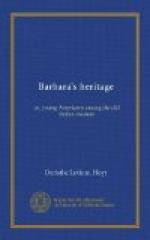Chapter VII.
A Startling Disclosure.
’Tis
even thus:
In that I live I love; because
I love
I live: Whate’er
is fountain to the one
Is fountain to the other.
—TENNYSON.
[Illustration: CLOISTER, MUSEUM OF SAN MARCO, FLORENCE.]
Many days of great distress followed. Everything else was forgotten in the tense waiting. There were moments of half consciousness when Malcom’s only words were “All right, mother.” It seemed as if even in that second of plunging to save the child he yet thought of his mother, and realized how she would feel his danger. But happily, as time wore on, the jarred brain recovered from the severe shock it had received, and gradually smiles took the place of anxious, questioning looks, and merry voices were again heard, and the busy household life was resumed.
Although Malcom could not accompany them, the proposed visit to the old monastery, San Marco, for study of Fra Angelico’s paintings was made by the others.
As they wandered through the long corridors, chapel, refectory, and the many little cells, now vacant, from the walls of which look forth soft, fair faces and still fresh, sweet colors laid there almost five hundred years ago by the hand of the painter-monk, they talked of his devotion, of his unselfish life and work; of his rejection of payment for his painting, doing it unto God and not unto men. They talked of his beginning all his work with prayer for inspiration, and how, in full faith that his prayer had been answered, he absolutely refused to alter a touch his brush had made; and of the old tradition that he never painted Christ or the Virgin Mary save on his knees, nor a crucifixion save through blinding tears; and their voices grew very quiet, and they looked upon each fresco almost with reverence.
“Fra Angelico stood apart from the growth of art that was taking place about him,” said Mr. Sumner. “He neither affected it nor was affected by it. We should call him to-day an ’ecstatic painter’—one who paints visions; the Italians then called him ‘Il Beato,’ the blessed. There are many other works by him,—although a great part, between forty and fifty, are here. You remember the Madonna and Child you saw in the Uffizi Gallery the other day, on whose wide gold frame are painted those angels with musical instruments that are reproduced so widely and sold everywhere. You recognized them at once, I saw. Then, a few pictures have been carried away and are in foreign art galleries, as I told you the other day. During the last years of his life the Pope sent for him to come to Rome, and there he painted frescoes on the walls of some rooms in the Vatican Palace. From that city he went to Orvieto, a little old city perched on the top of a hill on the way from Florence to Rome, in whose cathedral he painted a noble Christ, with prophets, saints, and angels. He died in Rome.”




